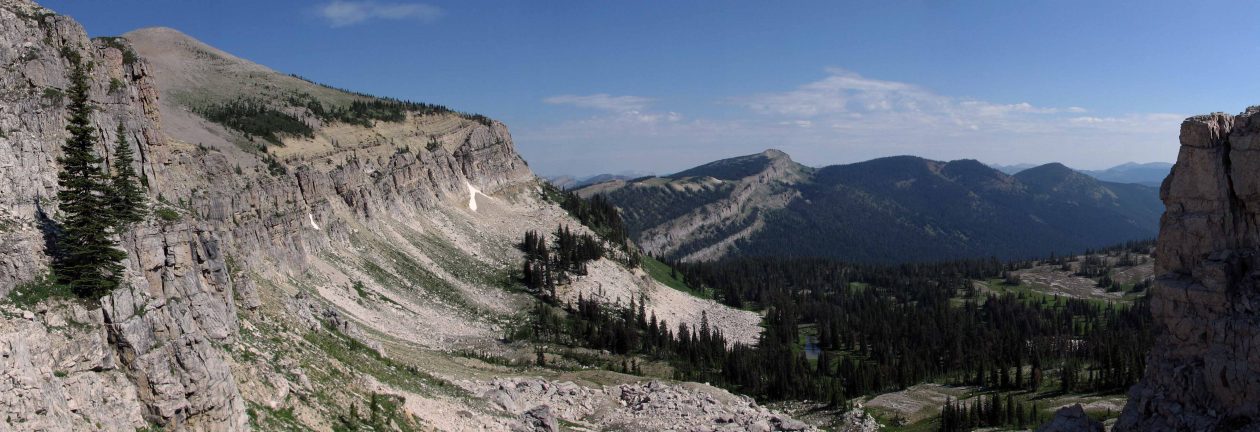Ayutthaya, Thailand
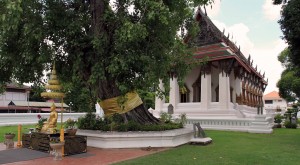
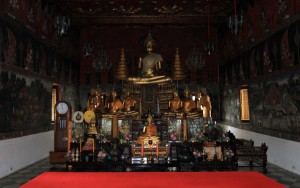
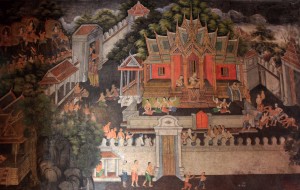
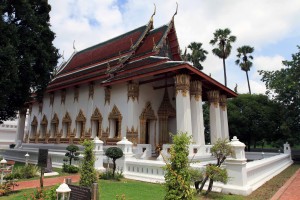
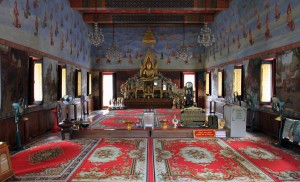
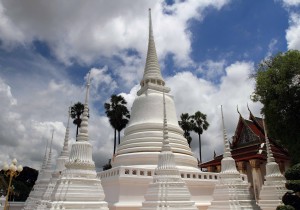
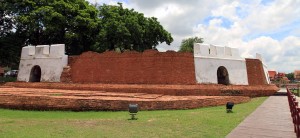
I slept in today, too tired to get out of bed early, so I got a late start; although I still managed to see quite a bit of Ayutthaya today. Ayutthaya was founded in 1350 AD by King U Thong and became the second capital of the Siam (or “Ayutthaya”) Kingdom, which lasted from 1351 to 1767 – in 1767, the Burmese Army destroyed the city and the Siam Kingdom collapsed, but many ruins (mostly monasteries) remain, giving tourists like me an idea of its glorious past. I started my day by crossing over the Pasak River to Ayutthaya City Island and walking west to Wat Suwan Dararam, which consisted of two halls (the ordination hall (“ubosot”) and the sermon hall (“vihara”) – both have many paintings on their inside walls), a large stupa (“chedi”) surrounded by smaller stupas, and a short belfry (“ho ra-kang”); I walked inside each hall and looked at the various statues and paintings, and I also studied the architecture on the outside – particularly the ordination hall which had a curved base (a characteristic of Ayutthaya-style). Then, after I finished looking around the monastery, I walked to the nearby Phet Fortress (“Pom Phet”, also known as the “Diamond Fortress”); the fortress in situated where the Pasak River meets the Chao Phraya River and is assumed to have been built circa 1580 AD; it was also one of sixteen fortresses built around Ayutthaya, but Phet Fortress is the only one that has visible ruins today; there wasn’t much to see here, so after a quick stroll around the remaining section of wall, I was soon back on the road, walking west to my next destination: the Ayutthaya Historical Study Center . . . which was closed (as I found out upon arrival) due to today being a Monday (I’ll have to visit it tomorrow to learn more about the city’s and kingdom’s history).
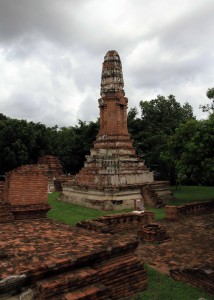
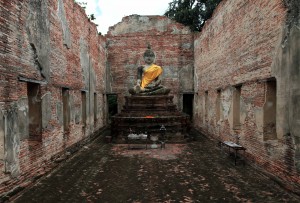
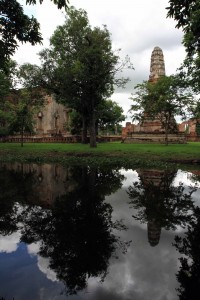
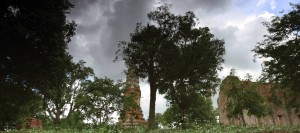
I then walked to Wat Borom Phuttharam (“Monastery of the Grand Buddha”) and walked around its ruins, which consisted of an ordination hall with a large Buddha statue in meditation posture on a brick base, a sermon hall, and two stupas (built in prang shape); Wat Borom Phuttharam was built in the late Ayutthaya Period (1629-1767)in 1689 and took two years to complete; these ruins were also located next to a narrow canal and across the canal was another temple – Wat Singharam which consisted of a hall and two stupas.
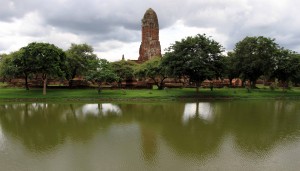
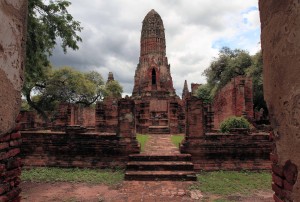
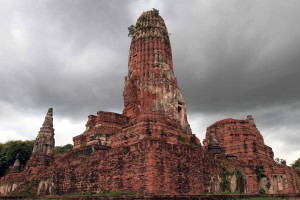
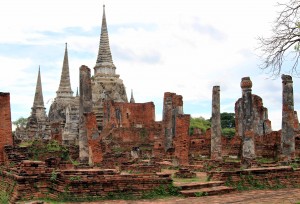
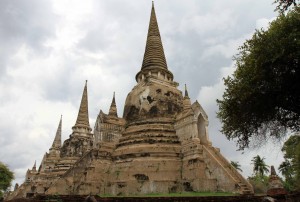
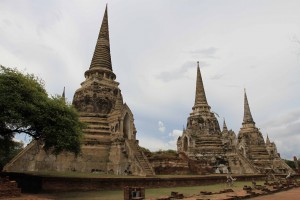
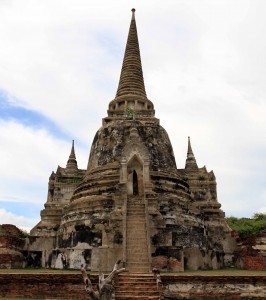
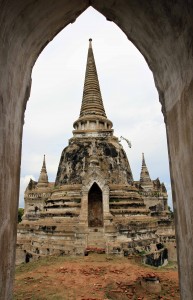
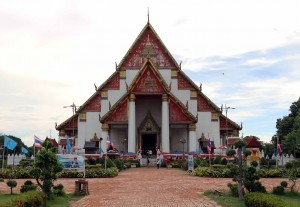
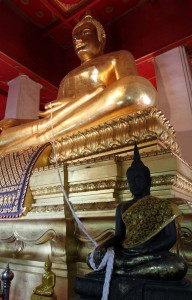
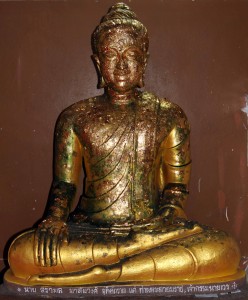
Next I walked north to Wat Phra Ram, located in the Ayutthaya Historical Park (which has many, many other ruins of monasteries). King Ramesuan began construction of Wat Phra Ram in 1369 on the cremation site of his father, King U Thong, but the monastery was not finished until well after his reign – sometime in the late-14th or 15th century (Note: this was a normal practice during the Siam Kingdom – to build a monastery with a large prang or stupa located where the funeral pyre of a deceased king had been). The most imposing structure in Wat Phra Ram is the principle prang, which is a tall tower-like spire that bears a striking resemblance to a phallus. I walked around these ruins for some time, before exiting the compound, walking past some elephants giving tourists rides, and entering in to the nearby monastery of Wat Phra Si Samphet, which was the most important monastery during the Siam Kingdom and was situated within the Royal palace grounds, to be used exclusively by Ayutthayan kings; the monastery contains three very large and impressive stupas (each containing ashes of past kings) and many other structures (now mostly reduced to ruins) that surround the three stupas. I walked around the grounds and walked up the steps of each stupa (or “chedi” – as they liked to be known as) to look inside the inner chamber of each one (Note: pretty much every chamber inside a prang or stupa in Ayutthaya had a number of bats hanging around; also, almost every Wat had packs of dogs mooching off the monks’ generosity (most were indifferent to visitors, but some would bark and try to verbally bully me away – maybe they thought I was a Communist coming to destroy their Buddhist temples and to execute their masters for not conforming to the state’s doctrine)). I spent a lot of time trying to capture every inch of Wat Phra Si Samphet with my camera, before walking to the temple directly adjacent to it – Wat Phra Mongkhon Bophit; this temple is a large white hall with a sloping, tiled roof that houses a gigantic bronze Buddha statue (seated in the position of subduing mara and measuring 9.55 meters wide and 12.45 meters high) that was originally constructed in sometime between 1448 and 1602, although the statue and the hall have been restored recently in the 20th-century due to a number of calamities striking the hall and statue during the course of their histories; the temple also had a number of Buddhist statues and busts that were speckled with pieces of some type of metallic leaf. After walking around the large Buddha statue and then the outside of the temple, I headed east to see more monasteries.
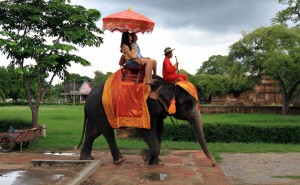
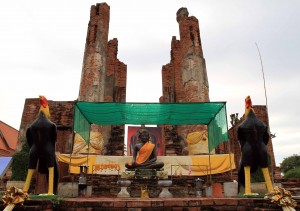
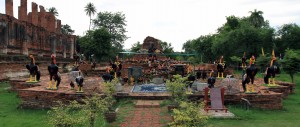
The next monastery I stopped at was Wat Thammikarat; this monastery, though mostly ruins, was more active than the other ruins I visited; there were several monks managing the temples on site and selling goods to worshipers and tourists; there were also a lot of dogs hanging about and several were in cages located along the south wall of the complex. The monastery has a stupa encircled by many lion statues, a large sculpture of Buddha’s head sitting atop a stone lotus flower, and four “halls” (one in ruins with a Buddha statue in front, another one with a Buddha statue seated inside, another one with a large reclining Buddha inside, and one (the “vihara”) that no longer has walls or a roof (its just the base bricks), but has probably the most statues of roosters to be found anywhere on Earth – a variety of sizes, from a few inches to about a meter tall). After walking around this monastery, I then walked east to the next one – Wat Maha That.
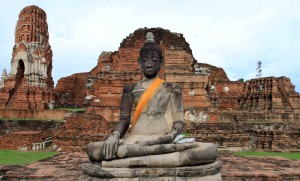
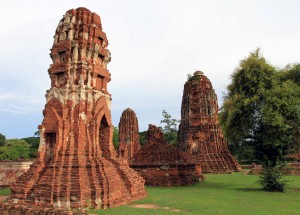
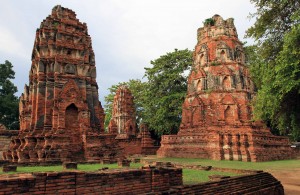
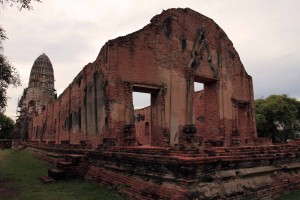
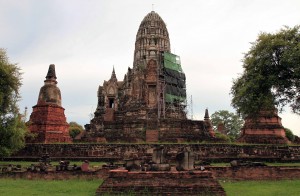
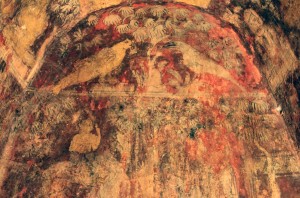
Wat Maha That began construction in the late 14th-century and had a large principle prang standing tall in the center; however, the principle prang (which had collapsed previously, but been restored each time in the past) collapsed for good in the beginning of the 20th-century; also, the crypt below the prang had contained relics of the Buddha – the repository with the relics was buried seventeen meters under the prang (probably to give strength to the stupa, which represents Mount Meru – the center of the universe in Buddhist doctrine). It is also worth noting, that by decree dating back to the pre-Ayutthaya period, a “Wat Maya That” was built in every provincial city at the time. I walked around what remained of the principle prang (basically a large brick base) and around all the other prangs and bell-shaped stupas found in the monastery compound. I then left the monastery and walked north to yet another monastery – the last one for the day -, Wat Ratchaburana. This monastery still had its principle prang standing tall, although a portion of the tower had scaffolding covering it due to restoration work being done on it. Wat Ratchaburana was constructed in 1424 during the reign of King Boromrachathirat II (according to the Royal Chronicles of Ayutthaya) on the site where the bodies of his two elder brothers were cremated. I first walked through the ruins of the vihara and then I walked around the principle prang before walking up the steps to a chamber at the top of the prang; inside this chamber, there were steep steps that led down to the crypt (the steps and much of the inside were modern constructions); I walked down to the bottom of the steps and then stepped up in to the crypt, which was a very small room that had faded frescoes painted on each of the four walls and the ceiling; I then climbed back up the steps inside the prang and then back down the steps outside the prang. After finishing looking at this monastery, I started walking back east toward the guesthouse.
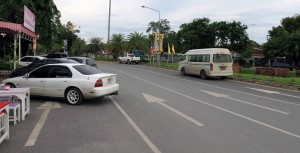
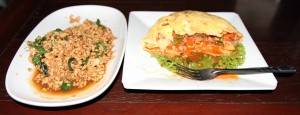
As I was walking back east I stopped for some liquid refreshment – boba green tea, which turned out to be amazingly delicious, much better than the regular boba milk tea (this may be Taiwan’s greatest contribution to humanity). I then continued on my way, passing through Chao Phrom Market, which was closing down for the day, and then crossing the Pasak River where I soon found an adequate restaurant to dine at – it was a floating restaurant on the Pasak River. For dinner I had a minced chicken dish with holy basil and garlic, a Thai-style omelette (which was very tasty), and a bottle of water (also, some mosquitoes had me!). After dinner, I walked back to my room in the guesthouse and stayed up too late again – hopefully I’ll manage to wake up early tomorrow morning.
